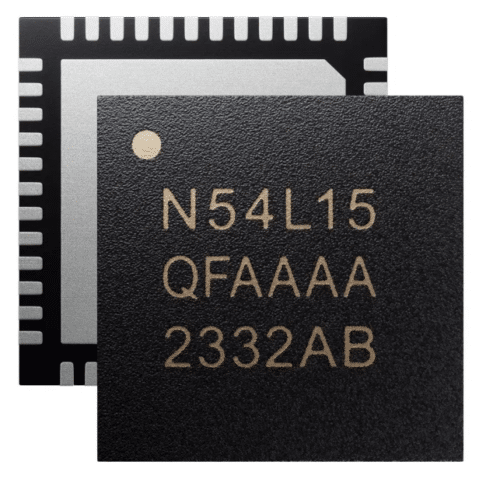Building on the success of its predecessor, this new microcontroller offers twice the performance and remarkable power efficiency, including a 50% reduction in receiver power consumption.

Nordic Semiconductor has introduced the nRF54L15 Cortex-M33 multi-protocol wireless microcontroller, part of the nRF54L Series, following the earlier release of the more powerful nRF54H20 dual-core Cortex-M33 MCU at 320 MHz last spring. While the previous one was crafted to facilitate innovative Internet of Things (IoT) devices, boasting significant performance gains and abundant resources like 2 MB of flash and 1 MB of SRAM, the new microcontroller sets its sights on enhancing the series. It offers twice the performance and substantially improved power efficiency, including a 50% reduction in receiver power consumption compared to its predecessor.
Key Features and Specifications include
CPU
- Arm Cortex-M33 @ up to 128 MHz with up to 1.5 MB Flash + 256 KB SRAM
- RISC-V coprocessor for “software-defined peripheral
Wireless
- Bluetooth 5.4 LE with direction-finding, Bluetooth mesh, etc… Ready for future Bluetooth releases
- 802.15.4 radio for Thread, Matter
- Proprietary 2.4 GHz up to 4 Mbps
- -96 dBm RX sensitivity @ 1 Mbps for Bluetooth LE
- Up to 8 dBm TX power
New peripherals
- Global Real-Time Clock (RTC)
- 14-bit Analog to Digital Coverter (ADC)
- Software-defined peripheral
Security
- Designed for Platform Security Architecture (PSA)Certified Level 3 IoT security standard
- TrustZone isolation, side-channel protection, and tamper detection
It has improvements in critical areas, particularly power consumption, with Rx current consumption being just half that of its predecessor, the nRF52840. It is available in two compact package options, the QFN48 measuring 6×6 mm and the ultra-compact wafer level chip scale package (WLCSP) with a mere 2.4×2.2 mm footprint. Furthermore, it is manufactured using aiwan Semiconductor Manufacturing Company (TSMC) advanced 22ULL (22 nm) process technology. It targets high-volume wireless IoT applications, including PC accessories, gaming controllers, remote controls, virtual reality and augmented reality devices, Smart Home appliances with Matter support, medical devices, and various industrial IoT uses.
The company currently offers microcontroller samples in the QFN48 package with 31 GPIOs.
Additionally, the company plans to release two ultra-compact WLCSP (Wafer-Level Chip Scale Package) options with a tiny 2.4×2.2mm footprint. These WLCSP packages will be more than 50% smaller , making them suitable for designs with strict size constraints. One of the WLCSP packages will provide 32 GPIOs with a 0.3mm pitch, while the other will feature 14 GPIOs with a 0.35mm pitch.







